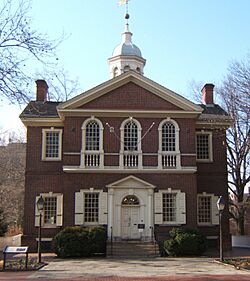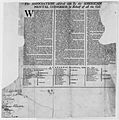First Continental Congress facts for kids
Quick facts for kids First Continental Congress |
|
|---|---|
 |
|
| Type | |
| Type | |
| History | |
| Established | September 5, 1774 |
| Disbanded | October 26, 1774 |
| Preceded by | Stamp Act Congress |
| Succeeded by | Second Continental Congress |
| Leadership | |
|
President
|
|
|
Secretary
|
|
| Seats | 56 from 12 of the 13 colonies |
| Meeting place | |
 |
|
| Carpenters' Hall in Philadelphia | |
The First Continental Congress was an important meeting of leaders from 12 of the Thirteen Colonies. It took place from September 5 to October 26, 1774, in Carpenters' Hall in Philadelphia. This meeting happened at the very beginning of the American Revolution.
The leaders met because the British Navy had blocked Boston Harbor. Also, the British Parliament had passed strict new laws called the Intolerable Acts. These laws were a punishment for the Boston Tea Party.
During the meeting, the delegates talked about how the colonies could work together. They wanted to respond to Britain's harsh actions. Their first big step was to agree on the Suffolk Resolves. This plan from Massachusetts asked for a trade boycott of British goods. It also encouraged each colony to start training its own local army, called a militia. The Congress also created a Declaration and Resolves. This included the Continental Association, which was a plan to stop trading with Britain. They also sent a Petition to the King, asking him to fix their problems and get rid of the Intolerable Acts.
This appeal to the King did not work. Because of this, the leaders decided to meet again. They formed the Second Continental Congress in Philadelphia the next May. This was right after the first battles of the American Revolutionary War at Battles of Lexington and Concord. The Second Congress would then organize the defense of the colonies.
Contents
Meeting the Delegates
The First Continental Congress met from September 5 to October 26, 1774. It was held in Carpenters' Hall in Philadelphia. Leaders, called delegates, from 12 of the Thirteen Colonies attended. The people of each colony, their local government, or a special committee chose these delegates.
The colony of Georgia did not send delegates at first. Many people there still supported Britain. However, Georgia did send delegates to the Second Continental Congress the next year.
Peyton Randolph was chosen as the president of the Congress. He served until October 22, when he had to leave due to illness. Henry Middleton then took his place. Charles Thomson was chosen as the secretary for the meeting. The rules they made helped make sure everyone had an equal say. They also encouraged open discussions.
As the meetings went on, it became clear that the delegates had different ideas. Some, like Joseph Galloway and John Dickinson, were more conservative. They wanted to find a way to make peace with Britain. They hoped to pressure the British Parliament to change its unfair laws. Their main goal was to solve the problems and bring the colonies and Great Britain back together.
Others, like Patrick Henry and Samuel Adams, had stronger views. They believed their job was to clearly state the rights of the colonies. They wanted to end what they saw as Britain's unfair use of power. They aimed to protect the rights that had been promised to the colonies.
Some delegates, like Roger Sherman, even said that the British Parliament had no right to make laws for the colonies. Patrick Henry thought the colonies needed a completely new government. He believed the old colonial governments were already gone. In contrast, Joseph Galloway suggested a "Plan of Union." This plan would create an American legislative body. This body would have some power and would need to agree to any laws from Britain.
Important Decisions and Actions
In the end, the delegates chose a path of compromise. They did not call for independence right away. Instead, the First Continental Congress passed and signed the Continental Association. This was part of their Declaration and Resolves. It called for a boycott of British goods. This boycott was set to begin in December 1774.
The Congress also agreed to stop importing enslaved people. This part of the boycott was planned to start on December 1. This would have ended the slave trade in the colonies much earlier than it actually happened.
What the Congress Achieved
The main achievement of the First Continental Congress was the agreement among the colonies. They decided to stop buying British goods starting December 1, 1774. This boycott would continue unless the British Parliament removed the Intolerable Acts.
While the Congress met, 51 women in Edenton, North Carolina, formed their own group. This group, now called the Edenton Tea Party, focused on making goods for the colonies. This helped support the boycott. The Congress also warned Britain's colonies in the West Indies. They said they would boycott them too if they kept importing British goods.
The boycott was very successful. Imports from Britain dropped by 97 percent in 1775 compared to the year before. Each colony set up committees to make sure everyone followed the boycott. The delegates also agreed that if the Intolerable Acts were not removed, they would stop exporting goods to Britain after September 10, 1775.
Most of the colonial governments approved what the Congress had done. Only New York did not. The boycott worked well, but the outbreak of fighting in April 1775 changed everything.
The Congress also voted to meet again the next year. This would happen if their problems were not solved. They expected to have a second meeting. So, they decided to invite other colonies that had not joined them. These included Quebec, Saint John's Island (now Prince Edward Island), Nova Scotia, Georgia, East Florida, and West Florida. Of these, only Georgia sent delegates to the next Congress.
List of Delegates
Images for kids
-
Embossed copy of the
Petition to the King -
Broadside copy of the
Continental Association -
200th anniversary of the First Continental Congress
commemorated on two 10-cent U.S. postage stamps
of the 1971–1983 Bicentennial Series -
200th anniversary of the First Continental Congress
commemorated on two 10-cent U.S. postage stamps
of the 1971–1983 Bicentennial Series -
Signatory page of the three-page Continental Association
signed by 53 of the 56 delegates
See also
 In Spanish: Primer Congreso Continental para niños
In Spanish: Primer Congreso Continental para niños






